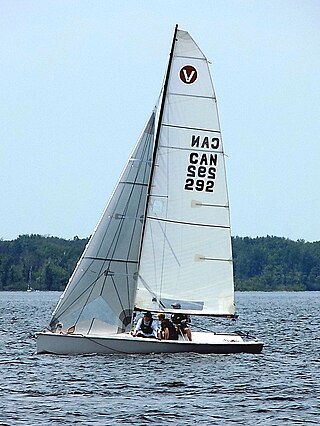
A sailboat or sailing boat is a boat propelled partly or entirely by sails and is smaller than a sailing ship. Distinctions in what constitutes a sailing boat and ship vary by region and maritime culture.

The keel is the bottom-most longitudinal structural element on a watercraft. On some sailboats, it may have a hydrodynamic and counterbalancing purpose, as well. The laying of the keel is often the initial step in the construction of a ship. In the British and American shipbuilding traditions, this event marks the beginning date of a ship's construction.

Dinghy sailing is the activity of sailing small boats by using five essential controls:

A daggerboard is a retractable centreboard used by various sailing craft. While other types of centreboard may pivot to retract, a daggerboard slides in a casing. The shape of the daggerboard converts the forward motion into a windward lift, countering the leeward push of the sail. The theoretical centre of lateral resistance is on the trailing edge of the daggerboard.

A centreboard or centerboard (US) is a retractable hull appendage which pivots out of a slot in the hull of a sailboat, known as a centreboard trunk (UK) or centerboard case (US). The retractability allows the centreboard to be raised to operate in shallow waters, to move the centre of lateral resistance, to reduce drag when the full area of the centreboard is not needed, or when removing the boat from the water, as when trailering. A centreboard which consists of solely a pivoting metal plate is called a centerplate. A daggerboard is similar but slides vertically rather than pivoting.

A leeboard is a form of pivoting keel used by a sailboat largely and very often in lieu of a fixed keel. Typically mounted in pairs on each side of a hull, leeboards function much like a centreboard, allowing shallow-draft craft to ply waters fixed keel boats cannot. Only the leeward side leeboard is used at any time, as it submerges when the boat heels under the force of the wind.
Ballast is used in ships to provide moment to resist the lateral forces on the hull. Insufficiently ballasted boats tend to tip or heel excessively in high winds. Too much heel may result in the vessel capsizing. If a sailing vessel needs to voyage without cargo, then ballast of little or no value will be loaded to keep the vessel upright. Some or all of this ballast will then be discarded when cargo is loaded.

Hobie Cat is a company that manufactures sailing catamarans, surfboards, sailboats, kayaks, stand-up paddle boards, and pedalboards as the Hobie Cat Company. It was founded in 1961 by Hobart Alter, who originally manufactured surfboards. Its line of products has included more than twenty sailing craft, plus a variety of other watercraft.

A canting keel is a form of sailing ballast, suspended from a rigid canting strut beneath the boat, which can be swung to windward of a boat under sail, in order to counteract the heeling force of the sail. The canting keel must be able to pivot to either port or starboard, depending on the current tack.

A sailing hydrofoil, hydrofoil sailboat, or hydrosail is a sailboat with wing-like foils mounted under the hull. As the craft increases its speed the hydrofoils lift the hull up and out of the water, greatly reducing wetted area, resulting in decreased drag and increased speed. A sailing hydrofoil can achieve speeds exceeding double and in some cases triple the wind speed.

A trailer sailer is a type of sailboat that has been designed to be easily transported using a boat trailer towed by an automobile. They are generally larger than a sailing dinghy. Trailer sailers include day sailers and small cabin cruisers, suitable for living on.

The Swan 46 Mk III, also called the Swan 461 and the Swan 46-3, is a Finnish sailboat that was designed by Germán Frers as a cruiser and first built in 2004.

The Viper 640 is an American trailerable sailboat, that was designed by Brian Bennett for racing and first built in 1996.
The AMF 2100 is an American trailerable sailboat that was designed by Ted Hood as a cruiser-racer and first built in 1980. The design's designation indicates its approximate length in hundredths of a foot.
The ETAP 23 is a Belgian trailerable sailboat that was designed by Jacques de Ridder as a cruiser and first built in 1982.
The ETAP 21i is a Belgian trailerable sailboat that was designed by Mortain & Mavrikios as a cruiser and first built in 1997.

The Matilda 20 is a trailerable sailboat that was designed by Robert Tucker as a daysailer and a cruiser and first built in 1971.
The Poacher 21, also called the Parker Dawson Poacher, is an American trailerable sailboat that was designed by W. Richardson as a racer-cruiser and first built in 1980.
The Schock 40 is an American sailboat that was designed by DynaYacht as a racer and first built in 2000.
The Melges 40 is an American sailboat that was designed by the Spanish design firm of Botin Partners as a one-design racer aimed at the European Grand Prix yacht racing circuit and first built in 2017.













